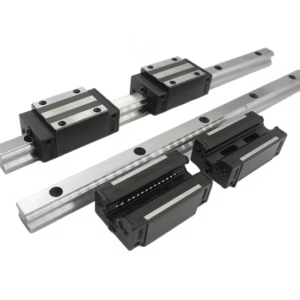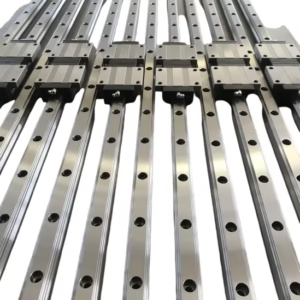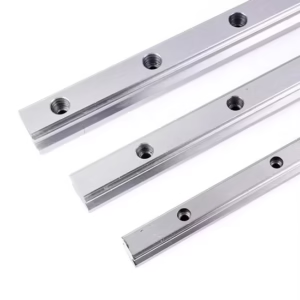Outline for Long-form Article on Linear Slide Rail
| Section | Subtopics |
|---|---|
| Introduction | What is a linear slide rail? Why it matters |
| Linear Slide Rail | Core definition and role in precision systems |
| History and Evolution of Slide Rails | From plain sliders to advanced rail systems |
| Key Components of a Linear Slide Rail | Rails, blocks, rolling elements, seals |
| How Linear Slide Rails Work | Recirculating elements, load transfer |
| Types of Linear Slide Rails | Profile rails, round rails, miniature rails |
| Advantages of Linear Slide Rails | Accuracy, rigidity, efficiency |
| Drawbacks and Limitations | Cost, contamination, installation |
| Applications in CNC Machines | Milling, turning, laser cutting |
| Applications in Robotics | Automation arms, cobots, pick-and-place |
| Applications in Medical Systems | Imaging, diagnostics, surgery tools |
| Applications in Aerospace and Defense | Assembly, testing, simulators |
| Applications in Packaging and Logistics | Conveyors, automated warehouses |
| Linear Slide Rail vs Other Motion Systems | Belts, bushings, wheels |
| Choosing the Right Linear Slide Rail | Load, environment, precision needs |
| Installation Best Practices | Alignment, torque, flatness |
| Maintenance of Linear Slide Rails | Lubrication, inspection, cleaning |
| Common Problems and Failures | Misalignment, wear, contamination |
| Future of Linear Slide Rail Technology | Smart sensors, predictive maintenance |
| Eco-friendly and Sustainable Rail Systems | Green materials, longer service life |
| Top Global Manufacturers | THK, HIWIN, Bosch Rexroth |
| Linear Slide Rails in DIY and Maker Projects | CNC routers, 3D printers |
| Cost Considerations | Factors influencing price |
| Buying Guide for Linear Slide Rails | Where to buy, quality checks |
| Linear Slide Rail | Recap and final insights |
| FAQs | Six practical questions and answers |
| Conclusion | Final thoughts and outlook |
Introduction
Imagine a CNC machine cutting through steel with micrometer precision or a robotic arm assembling electronics flawlessly. None of this would be possible without linear slide rails. These essential components provide the foundation for smooth, accurate, and repeatable motion in countless machines and devices.
In today’s world of high-speed automation and precision engineering, the linear slide rail has become a backbone of industries ranging from medical devices to aerospace. By reducing friction and supporting heavy loads, it allows modern machines to work faster, smarter, and longer.
Linear Slide Rail
A linear slide rail is a guiding system that allows one component to move in a straight line relative to another with minimal friction. It consists of a hardened steel rail and a sliding block or carriage that houses rolling elements like steel balls or rollers.
The main goal of a linear slide rail is to provide accurate and stable linear motion while supporting loads in multiple directions. Whether in a simple 3D printer or a complex aircraft assembly line, these systems ensure precision.
History and Evolution of Slide Rails
The earliest linear motion systems were simple plain slides or bushings, which worked but generated excessive friction and required constant lubrication. As industries demanded higher precision, engineers developed recirculating ball slide rails, transforming manufacturing in the late 20th century.
Today, we see advanced profile slide rails, miniature rails, and even smart slide rails equipped with sensors for predictive maintenance.
Key Components of a Linear Slide Rail
Rail: Precision-ground steel track.
Carriage/Block: Moves along the rail and holds rolling elements.
Rolling Elements: Steel balls or rollers that reduce friction.
Seals: Protect against dust and contaminants.
Lubrication System: Ensures smooth, long-lasting operation.
How Linear Slide Rails Work
The working principle is based on recirculating rolling elements. Steel balls or rollers inside the carriage circulate as the block moves along the rail. This rolling action minimizes resistance and distributes loads evenly.
The result? Smooth, accurate, and stable linear motion capable of handling both light and heavy-duty applications.
Types of Linear Slide Rails
Profile Rails: Square-edged, rigid, highly precise; ideal for CNC and aerospace.
Round Rails: Cylindrical shape, easier installation, more forgiving of misalignment.
Miniature Rails: Compact, lightweight, ultra-precise; used in medical and electronics.
Advantages of Linear Slide Rails
High precision and repeatability
Long service life with proper care
Ability to handle heavy loads
Reduced friction and noise
Compact and space-saving design
Increased machine speed and efficiency
Drawbacks and Limitations
Higher initial cost compared to bushings
Sensitive to dust, dirt, and moisture
Require careful alignment during installation
Dependence on lubrication for smooth operation
Applications in CNC Machines
CNC systems demand accuracy at high speeds. Linear slide rails are used in:
Milling machines
Grinding systems
Laser cutters
3D printers
They ensure the cutting tool or platform moves with stability.
Applications in Robotics
Robotic systems rely on linear slide rails for:
Robotic arms and manipulators
Automated pick-and-place systems
Collaborative robots (cobots)
These rails help robots perform precise, repeatable movements thousands of times per hour.
Applications in Medical Systems
The medical field requires high-accuracy tools powered by linear slide rails, including:
MRI and CT scanners
Surgical robotics
Laboratory automation
Miniature slide rails ensure smooth operation in delicate medical devices.
Applications in Aerospace and Defense
Aircraft assembly stations
Satellite deployment mechanisms
Flight simulators
Slide rails ensure rigidity, vibration resistance, and stability.
Applications in Packaging and Logistics
In high-speed packaging and warehouses, linear slide rails power:
Conveyor systems
Automated sorting and labeling machines
Pickers and palletizers
Linear Slide Rail vs Other Motion Systems
| Feature | Linear Slide Rail | Belts & Pulleys | Bushings |
|---|---|---|---|
| Precision | Very High | Medium | Low |
| Load Capacity | High | Medium | Low |
| Friction | Very Low | Medium | High |
| Durability | Long | Medium | Low |
| Cost | Higher | Lower | Lowest |
Choosing the Right Linear Slide Rail
Consider these factors:
Load requirements
Speed of operation
Precision needs
Environmental conditions
Budget
Installation Best Practices
Ensure rail alignment
Use flat, clean surfaces
Apply recommended torque levels
Test movement before full load operation
Maintenance of Linear Slide Rails
Lubricate regularly
Clean and protect against dust
Replace seals if worn
Monitor for unusual vibration or noise
Common Problems and Failures
Misalignment causing uneven wear
Lack of lubrication leading to friction
Contamination reducing smoothness
Overloading damaging the rails
Future of Linear Slide Rail Technology
Smart rails with sensors for predictive maintenance
Self-lubricating designs for reduced upkeep
Lightweight composite materials for efficiency
AI-driven monitoring to predict wear and failure
Eco-friendly and Sustainable Rail Systems
Longer lifespan reduces waste
Energy-efficient motion systems
Use of recyclable materials in production
Top Global Manufacturers
THK (Japan)
HIWIN (Taiwan)
Bosch Rexroth (Germany)
NSK Motion Solutions (Japan)
SKF (Sweden)
Linear Slide Rails in DIY and Maker Projects
Makers and hobbyists use slide rails in:
3D printers
Laser engravers
These systems make affordable precision engineering accessible to everyone.
Cost Considerations
Price depends on:
Rail type (profile vs round)
Bearing design (ball vs roller)
Precision grade
Manufacturer reputation
Buying Guide for Linear Slide Rails
Best options include:
Manufacturer-direct orders
Industrial suppliers like McMaster-Carr
Online marketplaces for hobbyist kits
Linear Slide Rail
In essence, the linear slide rail is the foundation of precision motion in countless industries. From medical tools to aerospace engineering, it ensures reliability, accuracy, and efficiency.
FAQs
What is a linear slide rail used for?
It guides precise, smooth, straight-line motion in machines.
Do linear slide rails need lubrication?
Yes, lubrication reduces wear and ensures smooth operation.
Which is better: profile rails or round rails?
Profile rails are more precise, while round rails are easier to install.
Can linear slide rails handle heavy loads?
Yes, especially profile rails with roller bearings.
Are linear slide rails expensive?
They are costlier than bushings but offer long-term savings.
Can they be used in outdoor environments?
Yes, with protective coatings and seals.
Conclusion
The linear slide rail is a small component with a huge impact. It powers industries by providing the precision and reliability that modern automation demands. From CNC machines to medical equipment, slide rails continue to shape the future of technology.
As innovations like smart sensors and self-lubricating materials emerge, the role of linear slide rails will only grow. Whether in a factory, a lab, or a DIY workshop, they remain essential for smooth, accurate, and efficient motion.




